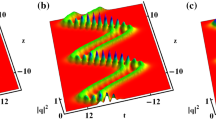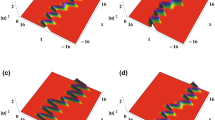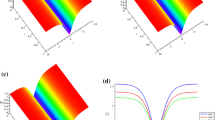Abstract
Optical fiber communication has developed rapidly because of the needs of the information age. Here, the variable coefficients fifth-order nonlinear Schrödinger equation (NLS), which can be used to describe the transmission of femtosecond pulse in the optical fiber, is studied. By virtue of the Hirota method, we get the one-soliton and two-soliton solutions. Interactions between solitons are presented, and the soliton stability is discussed through adjusting the values of dispersion and nonlinear effects. Results may potentially be useful for optical communications such as all-optical switches or the study of soliton control.
Similar content being viewed by others
Explore related subjects
Discover the latest articles, news and stories from top researchers in related subjects.Avoid common mistakes on your manuscript.
1 Introduction
Optical communication has developed rapidly, which is one of the supporting systems of the modern internet age [1,2,3,4,5,6,7,8,9]. The solitons have been investigated extensively after they were proposed in 1980, because they can keep their shapes to transmit in a long distance for the balance between the dispersion and nonlinear effects [10,11,12,13,14,15,16,17,18]. Besides, some methods have been used to solve the soliton solutions [19,20,21,22,23,24]. Furthermore, soliton interactions have been used to design optical switches [25,26,27,28]. Therefore, the research of solitons is hot in nonlinear science, and solitons have turned into an important topic in the area of communication systems [29,30,31,32].
In this paper, we will study soliton interactions in an inhomogeneous optical fiber by the following fifth-order nonlinear Schödinger (NLS) equations [33]:
where \(u(x,t)\) is a function, which represents the varying envelope wave. x is the normalized distance, and t is the normalized time. \(d_{1}(x)\) is the group velocity dispersion (GVD), \(a_{1}(x)\) is the fifth-order dispersion, and \(d_{2}(x)\) is the Kerr nonlinearity. \(a_{j}(x)(j=2,3,4,5)\) are the fifth-order nonlinearity coefficients.
As we all know, two-soliton interactions are important. By studying the soliton interactions, we can effectively enhance the communication capacity and improve the stability of the system [34,35,36]. Besides, to improve the quality of the communication in some long-distance optical systems, some factors such as higher-order dispersion and nonlinear effects should be considered [37,38,39,40]. Further, when the soliton duration is femto-second, high-order dispersion and high-order nonlinear effects will appear while solitons are transmitted in optical fibers. Meanwhile, the variable coefficient NLS equation can describe physical phenomenon more generally than the constant-coefficient equations [41,42,43,44]. Thus, it is necessary to use Eq. (1) to study the soliton interactions and analyze the nonlinear dynamic characteristics of these higher-order effects [11]. For Eq. (1), the dark soliton solutions and the integrability have been given [33]. However, the bright two-soliton solutions of Eq. (1) and their interactions have not been investigated under certain constraints in the existing reports.
We will use the Hirota method to get the bright soliton solutions, and their interactions will be given in this paper. It is organized as: the bright soliton solutions will be given in part 2; the interactions between bright solitons will be carried out in part 3; the conclusion will be derived in part 4.
2 Analytic bright soliton solutions
We introduce a dependent variable \(u=g/f\) with g(x, t) as the complex one and f(x, t) as the real one [45]. Using this transformation, we can get the bilinear forms as [32]
Here, \(D_{t}\) and \(D_{x}\) are the bilinear operators [13]. We introduce the constrains as follows [33],
To get the bright one-soliton solutions, the functions of \(g\), \(f\), \(h\) and \(s\) can be expanded as follows:
Propagation characteristics of parabolic solitons for Eq. (1). Parameters are \(\phi _{1}=\sin x-x\), \(\phi _{2}=0.2x\) with a \(\omega =0.48+1.1i\), \(\delta =1+2i\); b \(\omega =0.68+1.1i\), \(\delta =1+2i\); c \(\omega =0.48+1.1i\), \(\delta =-2+2i\)
In-phase interaction characteristics of parabolic solitons for Eq. (1). Parameters are \(\phi _{1}=\sin x-x\), \(\phi _{2}=0.2x\), \(\omega _{1}=0.4-1.3i\), \(\omega _{2}=0.73+1.1i\), \(\delta _{1}=1+2i\) with a \(\delta _{2}=4+2i\); b \(\delta _{2}=2+2i\); c \(\delta _{2}=1+2i\)
And then we assume that
where \(\omega \) and \(\delta \) are the complex constants, \(k(x)\), \(\phi _{1}(x)\) and \(\phi _{2}(x)\) are real functions. Setting \(\varepsilon = 1\), we can get
We write the undetermined functions as follows to get the bright two-soliton solutions,
We assume that
where \(\omega \) and \(\delta \) are the complex constants, \(k(x)\), \(\phi _{1}(x)\) and \(\phi _{2}(x)\) are real functions. We set \(\varepsilon = 1\), and will get
Inverse interaction characteristics of parabolic solitons for Eq. (1). Parameters are \(\phi _{1}=\sin x-x\), \(\phi _{2}=0.2x\), \(\omega _{1}=0.8-1.3i\), \(\omega _{2}=-0.43+1.1i\), \(\delta _{2}=2+2i\) with a \(\delta _{1}=4+2i\); b \(\delta _{1}=1+2i\); c \(\delta _{1}=-2+2i\)
3 Discussion
We obtain the one-soliton and two-soliton solutions in Sect. 2, and the characteristics and interactions of solitons can be explored in this part. Taking different functions for \(\phi _{1}(x)\) and \(\phi _{2}(x)\) can result in different distributions of dispersion. In Fig. 1, there is a common soliton. When we set \(\omega =0.68+1.1i\), the soliton intensity in Fig. 1b gets lager compared with Fig. 1a. And then, we set \(\delta =-2+2i\), the soliton in Fig. 1c moves away while the other characteristics are not changed.
Some interactions between solitons are presented in Fig. 2, and the interactions between two solitons are discussed by changing \(\delta _{2}\) as different numbers. When we set \(\phi _{1}(x)=\sin (x)-x\) and \(\phi _{2}(x)=0.2x\), the two solitons are attracting and repelling each other periodically.
After we change \(\delta _{2}=2+2i\) and \(1+2i\), the distance between two solitons becomes smaller. The value of \(\delta _{2}\) gets smaller, two solitons get closer, and the intensity of interactions gets stronger. Therefore, we can control the distance between two solitons to reduce the relative effect by adjusting \(\delta _{2}\). This method can increase the soliton energy and amplitude effectively.
In Fig. 3, we can see two solitons spread in different directions. When we alter the real part of \(\delta _{1}\), one soliton moves along the t axis. Therefore, the interaction strength between solitons is changed because of the changing of the distance. When we let \(\delta _{1}\) to be \(1+2i\) and \(-2+2i\), respectively, the interaction strength between two solitons changes gradually. So we can control the interaction strength between solitons through controlling the value of \(\delta _{1}\).
4 Conclusion
We have studied the variable coefficients fifth-order NLS Eq. (1). The bright one-soliton and two-soliton solutions (4) and (7) have been obtained by the Hirota method. The interaction strength between solitons has been discussed theoretically. The intensity of solitons has been changed with the different numbers of \(\omega \). When we have increased the real part of \(\omega \), the soliton has gotten higher. Meanwhile, we have analyzed the influence of \(\delta _{1}\) and \(\delta _{2}\) on the soliton transmission. With the changes of the real parts of \(\delta _{1}\) and \(\delta _{2}\), the distance between solitons has gotten smaller or larger, so soliton interactions have become larger or smaller. As a result, we have realized how to control the interaction strength between solitons. The results in this work may have scientific value about the solitons transmission control.
Availability of data and material
The authors declare that all data generated or analyzed during this study are included in this article.
References
Ankiewicz, A., Wang, Y., Wabnitz, S., Akhmediev, N.: Extended nonlinear Schrödinger equation with higher-order odd and even terms and its rogue wave solutions. Phys. Rev. E 89(1), 012907 (2014)
Wazwaz, A.M.: A two-mode modified KdV equation with multiple soliton solutions. Appl. Math. Lett. 70, 1–6 (2017)
Wazwaz, A.M.: Abundant solutions of various physical features for the \((2+1)\)-dimensional modified KdV-Calogero–Bogoyavlenskii–Schiff equation. Nonlinear Dyn. 89, 1727–1732 (2017)
Wazwaz, A.M., EI-Tantawy, S.A.: Solving the \((3+1)\)-dimensional KP-Boussinesq and BKP-Boussinnesq equation by the simplified Hirota’s method. Nonlinear Dyn. 88, 3017–3021 (2017)
Wazwaz, A.M.: Multiple soliton solutions and other exact solutions for a two-mode KdV equation. Math. Methods Appl. Sci. 40, 2277–2283 (2017)
Wazwaz, A.M., EI-Tantawy, S.A. : A new integrable \((3+1)\)-dimensional KdV-like model with its multiple-soliton solutions. Nonlinear Dyn. 83(3), 1529–1534 (2016)
Wazwaz, A.M.: A study on a two-wave mode Kadomtsev–Petviashvili equation: conditions for multiple soliton solutions to exist. Math. Methods Appl. Sci. 40, 4128–4133 (2017)
Zhang, N., Xia, T.C., Fan, E.G.: A Riemann-Hilbert approach to the Chen–Lee–Liu equation on the half line. Acta Math. Appl. Sin. 34(3), 493–515 (2018)
Zhang, N., Xia, T.C., Jin, Q.Y.: N-Fold Darboux transformation of the discrete Ragnisco–Tu system. Adv. Differ. Equ. 2018, 302 (2018)
Mollenauer, L.F., Stolen, R.H., Gordon, J.P.: Experimental observation of picosecond pulse narrowing and solitons in optical fibers. Phys. Rev. Lett. 45, 1095 (1980)
Liu, W.J., Zhang, Y.J., Pang, L.H., Yan, H., Ma, G.L., Lei, M.: Study on the control technology of optical solitons in optical fibers. Nonlinear Dyn. 86, 1069–1073 (2016)
Hasegawa, A., Tappert, F.: Transmission of stationary nonlinear optical pulses in dispersive dielectric fibers. I. Anomalous dispersion. Appl. Phys. Lett. 23, 142–144 (2003)
Hirota, R.: The Direct Method in Soliton Theory. Cambridge Tracts in Mathematics, Cambridge University Press, Cambridge (2004)
Kivshar, Y.S., Haelterman, M., Emplit, P., Hamaide, J.P.: Gordon–Haus effect on dark solitons. Opt. Lett. 19, 19–21 (1994)
Liu, M.L., Liu, W.J., Pang, L.H., Teng, H., Fang, S.B., Wei, Z.Y.: Ultrashort pulse generation in mode-locked erbium-doped fiber lasers with tungsten disulfide saturable absorber. Opt. Commun. 406, 72–75 (2018)
Liu, W.J., Liu, M.L., OuYang, Y.Y., Hou, H.R., Ma, G.L., Lei, M., Wei, Z.Y.: Tungsten diselenide for mode-locked erbium-doped fiber lasers with short pulse duration. Nanotechnology 29, 174002 (2018)
Liu, W.J., Liu, M.L., Lei, M., Fang, S.B., Wei, Z.Y.: Titanium selenide saturable absorber mirror for passive Q-switched Er-doped fiber laser. IEEE J. Quantum. Elect. 24, 0901005 (2017)
Liu, W.J., Pang, L.H., Han, H.N., Tian, W.L., Chen, H., Lei, M., Yan, P.G., Wei, Z.Y.: Generation of dark solitons in erbium-doped fiber lasers based Sb\(_2\)Te\(_3\) saturable absorbers. Opt. Express 23, 26023–26031 (2015)
Kumar, S., Niwas, M., Wazwaz, A.M.: Lie symmetry analysis, exact analytical solutions and dynamics of solitons for (2+1)-dimensional NNV equations. Phys. Scr. 95(9), 095204 (2020)
Kumar, S., Kumar, D., Wazwaz, A.M.: Lie symmetries, optimal system, group-invariant solutions and dynamical behaviors of solitary wave solutions for a \((3+1)\)-dimensional KdV-type equation. Eur. Phys. J. Plus 136, 531 (2021)
Kumar, S., Kumar, A.: Lie symmetry reductions and group invariant solutions of \((2+1)\)-dimensional modified Veronese web equation. Nonlinear Dyn. 98, 1891–1903 (2019)
Kumar, S., Kumar, D., Wazwaz, A.M.: Group invariant solutions of \((3+1)\)-dimensional generalized B-type Kadomstsev Petviashvili equation using optimal system of Lie subalgebra. Phys. Scr. 94(6), 065204 (2019)
Kumar, S., Almusawa, H., Hamid, I., Abdou, M.A.: Abundant closed-form solutions and solitonic structures to an integrable fifth-order generalized nonlinear evolution equation in plasma physics. Results Phys. 26, 104453 (2021)
Kumar, S., Kumar, A.: Abundant closed-form wave solutions and dynamical structures of soliton solutions to the \((3+1)\)-dimensional BLMP equation in mathematical physics. J. Ocean Eng. Sci. (In Press). https://doi.org/10.1016/j.joes.2021.08.001
Ankiewicz, A., Akhmediev, N.: Higher-order integrable evolution equation and its soliton solutions. Phys. Lett. A 378(4), 358–361 (2014)
Chen, C.J., Wang, P.K., Menyuk, C.R.: Soliton switch using birefringent optical fibers. Opt. Lett. 15(9), 477 (1990)
Dai, C.Q., Zhou, G.Q., Chen, R.P., Lai, X.J., Zheng, J.: Vector multipole and vortex solitons in two-dimensional Kerr media. Nonlinear Dyn. 88, 2629–2635 (2017)
Abdullaev, F.K., Garnier, J.: Dynamical stabilization of solitons in cubic-quintic nonlinear Schrödinger model. Phys. Rev. E 72, 035603R (2005)
Mollenauer, L.F., Neubelt, M.J., Evangelides, S.G., Gordon, J.P., Simpson, J.R., Cohen, L.G.: Experimental study of soliton transmission over more than 10,000 km in dispersion-shifted fiber. Opt. Lett. 15, 1203–1205 (1990)
Mollenauer, L.F., Smith, K.: Demonstration of soliton transmission over more than 4000 km in fiber with loss periodically compensated by Raman gain. Opt. Lett. 13, 675–677 (1988)
Malomed, B.A., Mostofi, A., Chu, P.L.: Transformation of a dark soliton into a bright pulse. J. Opt. Soc. Am. B 17, 507–513 (2000)
Sun, Y., Tian, B., Wu, X.Y., Liu, L., Yuan, Y.Q.: Dark solitons for a variable-coefficient higher-order nonlinear Schrödinger equation in the inhomogeneous optical fiber. Mod. Phys. Lett. B 31, 1750065 (2017)
Huang, Q.M.: Integrability and dark soliton solutions for a high-order variable coefficients nonlinear Schrödinger equation. Appl. Math. Lett. 93, 29–33 (2019)
Wang, L.L., Liu, W.J.: Stable soliton propagation in a coupled \((2+1)\) dimensional Ginzburg–Landau system. Chin. Phys. B 29(7), 070502 (2020)
Cao, Q.H., Dai, C.Q.: Symmetric and anti-symmetric solitons of the fractional second-and third-order nonlinear Schrödinger equation. Chin. Phys. Lett. 38(9), 090501 (2021)
Yan, Y.Y., Liu, W.J.: Soliton rectangular pulses and bound states in a dissipative system modeled by the variable-coefficients complex cubic-quintic Ginzburg–Landau equation. Chin. Phys. Lett. 38(9), 094201 (2021)
Chen, H.H., Lee, Y.C.: Internal-wave solitons of fluids with finite depth. Phys. Rev. Lett. 43, 264–266 (1979)
Lan, Z.Z., Gao, B.: Lax pair, infinitely many conservation laws and solitons for a \((2+1)\)-dimensional Heisenberg ferromagnetic spin chain equation with time-dependent coefficients. Appl. Math. Lett. 79, 6–12 (2018)
Lan, Z.Z.: Conservation laws, modulation instability and solitons interactions for a nonlinear Schrödinger equation with the sextic operators in an optical fiber. Opt. Quant. Electron. 50, 340 (2018)
Lan, Z.Z., Gao, B., Du, M.J.: Dark solitons behaviors for a \((2+1)\)-dimensional coupled nonlinear Schrödinger system in an optical fiber. Chaos, Solitons Fractals 111, 169–174 (2018)
Xie, X.Y., Meng, G.Q.: Collisions between the dark solitons for a nonlinear system in the geophysical fluid. Chaos, Solitons Fractals 107, 143–145 (2018)
Zhang, Y.J., Zhao, D., Luo, H.G.: The role of middle latency evoked potentials in early prediction of favorable outcomes among patients with severe ischemic brain injuries. Ann. Phys. 350, 112 (2014)
Wu, X.Y., Tian, B., Yin, H.M., Du, Z.: Rogue-wave solutions for a discrete Ablowitz-Ladik equation with variable coefficients for an electrical lattice. Nonlinear Dyn. 93, 1635 (2018)
Chai, J., Tian, B., Wang, Y.F.: Mixed-type vector solitons for the coupled cubic-quintic nonlinear Schrödinger equations with variable coefficients in an optical fiber. Phys. A 434, 296 (2015)
Zhang, Y.J., Yang, C.Y., Yu, W.T., Liu, M.L., Ma, G.L., Liu, W.J.: Some types of dark soliton interactions in inhomogeneous optical fibers. Opt. Quant. Electron. 50, 295–302 (2018)
Acknowledgements
We acknowledge the financial support from the National Natural Science Foundation of China (Grant Nos. 11875009, 11905009, 12075034).
Author information
Authors and Affiliations
Corresponding author
Ethics declarations
Conflict of interest
The authors declare that they have no conflict of interest concerning the publication of this manuscript.
Ethical approval
The authors declare that they have adhered to the ethical standards of research execution.
Additional information
Publisher's Note
Springer Nature remains neutral with regard to jurisdictional claims in published maps and institutional affiliations.
Rights and permissions
About this article
Cite this article
Ma, G., Zhao, J., Zhou, Q. et al. Soliton interaction control through dispersion and nonlinear effects for the fifth-order nonlinear Schrödinger equation. Nonlinear Dyn 106, 2479–2484 (2021). https://doi.org/10.1007/s11071-021-06915-0
Received:
Accepted:
Published:
Issue Date:
DOI: https://doi.org/10.1007/s11071-021-06915-0







